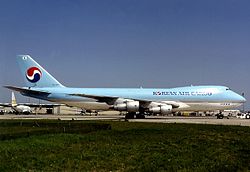This article has multiple issues. Please help improve it or discuss these issues on the talk page . (Learn how and when to remove these messages)
|
 HL7451, the aircraft involved in the accident, photographed in 1992 | |
| Accident | |
|---|---|
| Date | 22 December 1999 |
| Summary | Crashed shortly after take off due to pilot error caused by instrument failure compounded by poor CRM |
| Site | Great Hallingbury, England, United Kingdom 51°51′23″N0°12′59″E / 51.85639°N 0.21639°E [1] |
| Aircraft | |
| Aircraft type | Boeing 747-2B5F |
| Operator | Korean Air Cargo |
| IATA flight No. | KE8509 |
| ICAO flight No. | KAL8509 |
| Call sign | KOREAN AIR 8509 |
| Registration | HL7451 |
| Flight origin | Gimpo International Airport, Seoul, South Korea |
| 1st stopover | Tashkent International Airport, Tashkent, Uzbekistan |
| 2nd stopover | London Stansted Airport, England, United Kingdom |
| Destination | Milan Malpensa Airport, Milan, Italy |
| Occupants | 4 |
| Crew | 4 |
| Fatalities | 4 |
| Survivors | 0 |
Korean Air Cargo Flight 8509 was a Boeing 747-2B5F, registered HL7451 bound for Milan Malpensa Airport, that crashed due to instrument malfunction and pilot error on 22 December 1999 shortly after take-off from London Stansted Airport where the final leg of its route from South Korea to Italy had begun. The aircraft crashed into Hatfield Forest near the village of Great Hallingbury, close to, but clear of, some houses, killing all four crew members on board. [2] [3]

